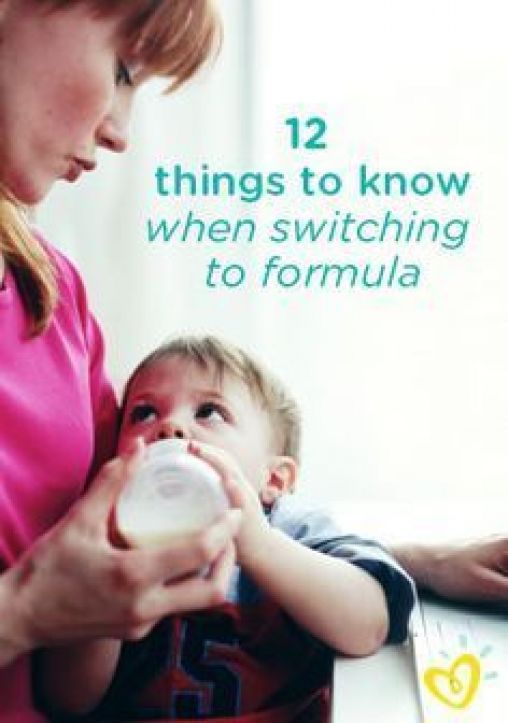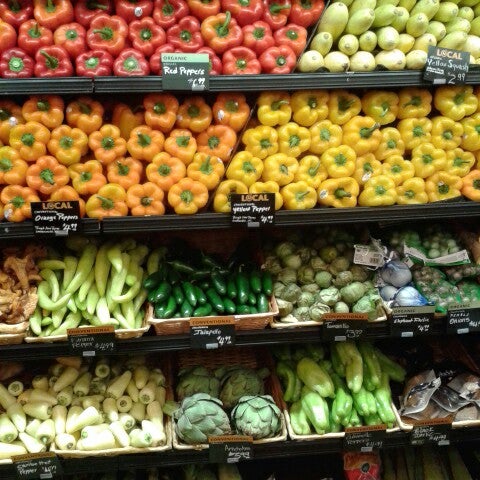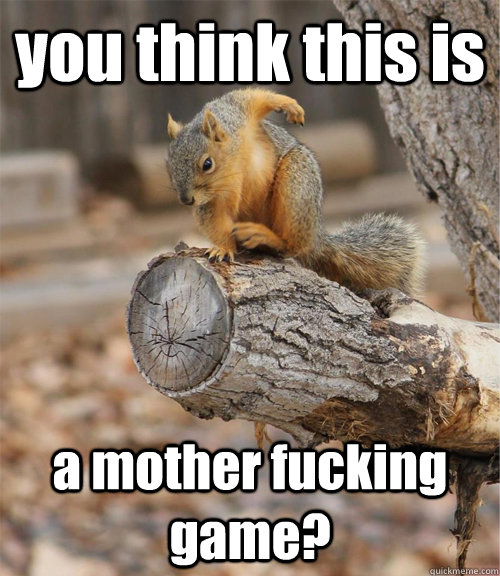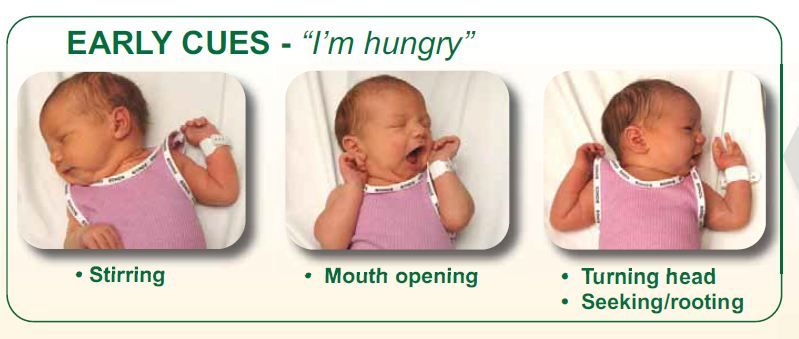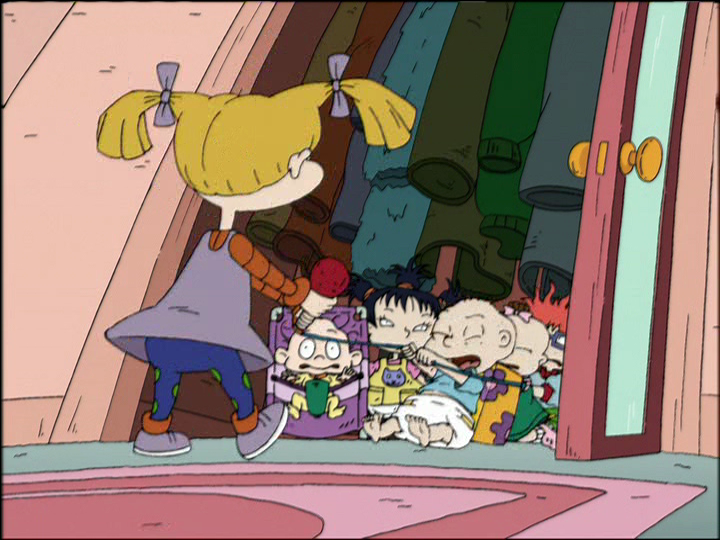Care and feeding of wild baby rabbits
How To Keep A Wild Baby Rabbit Alive — Rabbit Care Tips
Wild newborn bunnies are kept in small, shallow nests in grassy areas near woodland, bushes, or out in the open. While an open space might seem like a dangerous place for a rabbit to set up home, predators are less likely to venture to exposed areas. So, when you stumble across a nest, it’s worrying to see a group of baby rabbits alone.
To keep a wild baby rabbit alive, you must determine whether the mother is around. Mother rabbits only return to the nest twice a day to feed their kits. If they are orphaned, you will need to provide a nest, maintain the right temperature, and provide a healthy diet. You will also need to stimulate urination and defecation and source nutritious cecotropes. Injured bunnies will need immediate veterinary care.
Fewer than 10% of orphaned wild rabbits survive longer than a week. Attempts to care for orphaned rabbits often do more harm than good, so proceed with caution if you find a nest with no mother in sight. You don’t want to intervene until you know that your help will make a difference.
How to Help A Wild Baby Rabbit Survive
Most wild baby rabbits aren’t orphaned. While your immediate reaction may be to call for help, this isn’t always necessary. A doe will never abandon her kits by choice. Death or environmental issues where the nest can’t be accessed are the only reasons why she wouldn’t be around.
As described by the Indiana Department of Natural Resources, cottontail doe rabbits only return to the nest a few times a day to deter predators. Baby rabbits don’t have a scent until they get older. As predators can sniff out the doe, her presence puts her babies in danger.
The doe will leave her babies hidden and camouflaged in the nest to protect them, returning between dusk and dawn to feed her young.
Feeding is quick and only takes between 2-3 minutes, making it difficult to tell whether the baby rabbits are orphaned or not. If you suspect that a baby rabbit is orphaned, look out for the following signs:
- A sunken stomach, which indicates that the bunny isn’t feeding.
 Well-fed rabbits should have a full, rounded abdomen.
Well-fed rabbits should have a full, rounded abdomen. - The bunny doesn’t try to run away from you but seems sluggish and unhealthy.
- A healthy pink skin tone. Bunnies with wrinkled or thin, blue skin are likely to be starving.
- Vocalization indicates that the baby rabbit is frightened and hungry. Healthy rabbits are usually silent because they know that noise attracts predators.
To be sure whether the baby rabbits are orphaned, carry out the string test. For this, you’ll need a few pieces of cotton or string. Place them over the nest in a pattern you can easily remember (or take a picture) and leave it overnight.
If the string has moved in the morning, the mother rabbit has been back to feed her kits. If not, the bunnies are likely orphaned. At this point, you’ll need to call a wildlife rehabilitator for advice.
Build A Nest
If you know the mother is still caring for her babies, leave the nest alone. If you disturb a nest and discover that the doe is still around, remake it and leave the baby rabbits where you found them.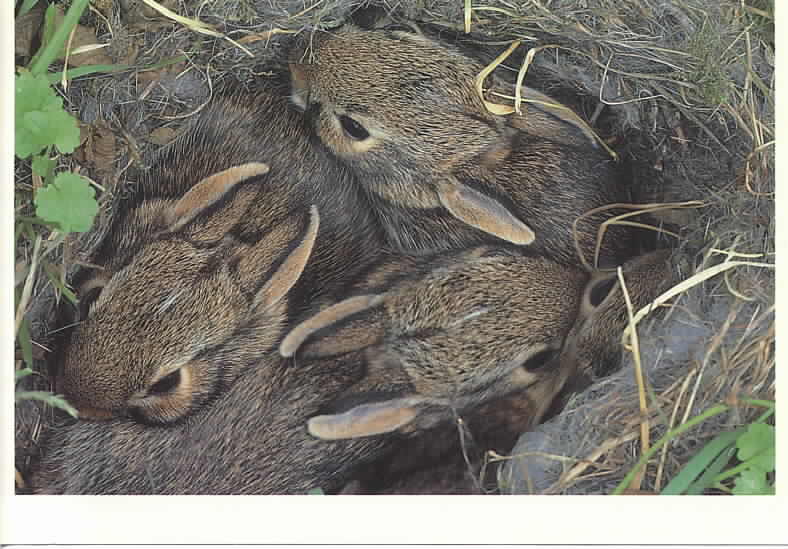 Despite some misconceptions, a mother won’t abandon her kits if you touch them.
Despite some misconceptions, a mother won’t abandon her kits if you touch them.
On the other hand, if the doe is no longer around, you’ll need to provide a nest for the baby rabbits to survive.
The nest’s primary purpose is to keep the kits warm. A mother rabbit builds her nest using fur, dry leaves, and grass. She then covers it using more dried grass and hair. Baby rabbits only live in the nest for three weeks, so you don’t need to provide a makeshift nest for long.
The University of Miami advises that creating a nest as close as possible to the one a mother rabbit would make is best. Use a shallow cardboard box and fill it with clean cotton wadding or bunny fur (if you can find some). Then, cover the top of the box with a small, light towel, allowing a little gap for air to get in.
Multiple orphaned bunnies will snuggle to keep warm, so you mustn’t use an electric heating pad as they can be dangerous.
However, if your orphaned bunny is on its own, you can provide heat using a warm water bottle wrapped in a soft towel.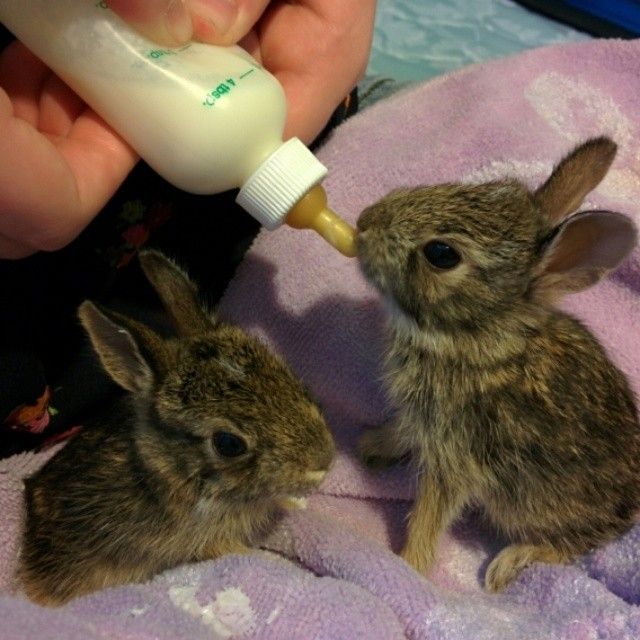 Ensure that the bunny can move away from the bottle if it gets too hot.
Ensure that the bunny can move away from the bottle if it gets too hot.
Maintain the Right Temperature
A baby rabbit’s body temperature is higher than ours. Bunnies need to feel warm to survive. If they get too cold too quickly, they will become unwell and may even stop moving.
To keep your orphaned bunnies healthy, keep the nest at 95-98 degrees for the first 2 weeks. After 2 weeks, you can lower the temperature by 3-5 degrees each day until you reach room temperature, which is around 68-72 degrees.
As a wild bunny grows older, protect it from extreme cold and heat. As described by Vetstream, rabbits are unable to sweat or pant and cannot dissipate efficiently. As a result, high temperatures can lead to life-threatening hyperthermia.
Feed the Wild Rabbits
Where the doe isn’t present, a baby rabbit will need hand feeding. Rabbits rely on milk to survive, so they should be fed kitten milk replacer or Meyenberg goat milk.
Cow’s milk might seem like a healthy choice, but it’s full of hormones, blood, pus, lactose, and traces of medication, which baby rabbits can’t digest. Rabbits are unable to vomit and, as a result, their sensitive stomachs can’t remove toxic substances from the body.
Milk is all a rabbit will consume for the first two weeks of its life. At two weeks, a bunny will start eating solids. From 4 weeks old, a bunny will eat the same food as its mother. However, milk will still play a vital part in the diet for the first six weeks, so make this a staple part of the bunny’s diet.
How to Make A Substitute Bunny Milk Formula
If you don’t have access to kitten milk replacer, you’ll need to make an orphaned bunny milk formula. It’s easy to do following this recipe:
- Mix one cup of goat milk with 56 grams of powdered goat milk.
- Add one tablespoon of sugar-free whipping cream to make the formula richer and contain more calories.
- Heat the formula to 98-100 degrees Fahrenheit.

- Leave the formula to cool slightly before feeding the rabbit.
While a pre-mixed milk replacement is much easier to use, the above recipe is a nutritious alternative when a ready-made formula isn’t available. It also contains the same vital nutrients as the mother rabbit’s milk so will help the bunny grow up strong and healthy.
How Many Times to Feed
Baby rabbits should be fed the following volumes of milk twice a day:
- Newborn to one week: feed between 22 ½ ml of milk per feeding.
- 1-2 weeks: feed between 5-7 ml of milk during per feeding. If the rabbit is particularly small, reduce the amount of milk to suit the size.
- 2-3 weeks: feed between 7-13 ml of milk per feeding.
- 3-6 weeks: feed between 13-15ml of milk per feeding.
Pay attention to how much the baby rabbit feeds as you may need to adjust the amount of milk given. Also, feed the baby rabbit at the same times each day to help form a solid routine.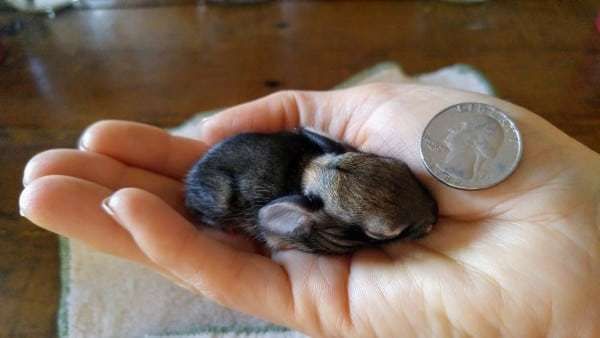
How to Feed
Baby rabbits lay on their backs while feeding from their mothers. To help a baby rabbit to survive, you’ll need to replicate this process.
Before feeding, wrap your rabbit in a soft cloth or hand towel and lay it gently in your gap. Ensure the baby rabbit isn’t laying straight back but is sat slightly upright so that the fluid doesn’t fill its lungs.
The first and easiest way to feed your baby rabbit is by syringe. 1ml syringes are best for newborn kits, while 2ml syringes are suitable for rabbits over three weeks old. To use, simply draw the right amount of milk out and release it slowly into the corner of its mouth.
However, you might find that the baby rabbit takes to a bottle better. When using a bottle, make sure it is completely sterile before use and place the nipple into the corner of the rabbit’s mouth. Slowly release the milk quantity to the correct level – you mustn’t overfeed.
Finally, a small, shallow dish is ideal for bunnies over two weeks old. Raise it about an inch off the floor and encourage the bunny to lap the formula by placing a drop or two onto your fingers. Never leave the dish out as the bunny could drown.
Raise it about an inch off the floor and encourage the bunny to lap the formula by placing a drop or two onto your fingers. Never leave the dish out as the bunny could drown.
Whichever way you choose to feed, be careful to go at the rabbit’s pace as feeding it too quickly can lead to suffocation.
Stimulate Urination and Defecation
Baby rabbits can’t release urine or feces until they open their eyes after ten days. In the wild, a mother rabbit stimulates her baby’s belly and anogenital region with her tongue. Where a doe is absent, you’ll need to help the rabbit relieve itself each time it’s fed. Follow these steps to help your orphaned rabbit urinate and defecate:
- With sanitized hands, wet a cotton ball with lukewarm water.
- Pop the bunny on its back, keeping it secure, and gently rub its genital area and abdomen. After a little while, the rabbit should begin to relieve itself.
- Clean up any urine or poop with a new, clean cotton ball.
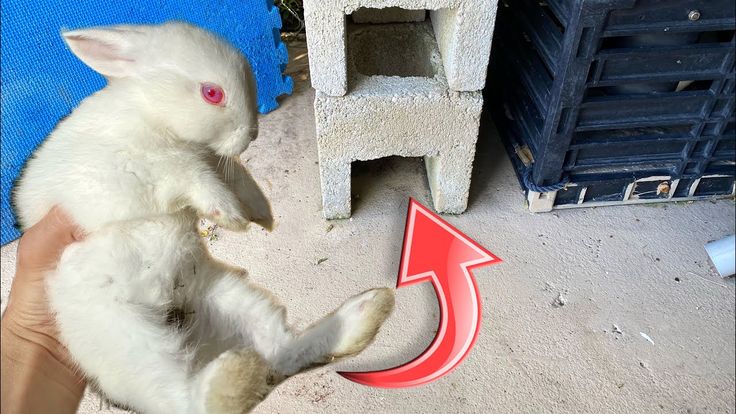
- Make sure the bunny’s urine and feces look healthy and regular. If not, seek help.
After the bunny opens its eyes, it will begin to urinate and defective for itself. But this step is an important one, as newborn rabbits can become unwell if it’s unable to empty its bladder and bowels.
Provide Cecotropes
Cecotropes are an essential part of any rabbit’s diet. They’re grape-like droppings formed in the cecum and provide a range of nutrients and good bacteria that protect against pathogens.
Immediately after producing them from the anus, rabbits eat the cecotropes. While unpleasant to us humans, this is entirely normal. If your bunny is producing and consuming them naturally, there’s nothing else for you to do.
However, if no cecotropes are being produced, sourcing them from a healthy adult rabbit provides a rich source of nutrients to help the bunny grow strong and healthy.
To get them into the newborn bunny’s digestive system, mix them with kitten milk replacer and feed the rabbit as per the recommended amount for its size and age.
Caring for An Injured Wild Baby Rabbit
Finding an injured rabbit adds another layer of complexity. An orphaned wild rabbit’s survival rate is already low, so you’ll need to move quickly to save the rabbit from further pain and distress.
In any case, calling a wildlife rehabilitator is essential. In the meantime. follow these care tips for the most common types of injuries:
Rabbit Is Dragging Back Legs
If a wild orphaned bunny is dragging its back legs, it’s likely suffering from a spinal cord injury, paralysis, or hind leg weakness. Though, muscle failure is attributed to old age, so this is an unlikely cause of a newborn bunny’s poor back leg function.
If you know the bunny hasn’t suffered a broken spine, the following causes are possible:
- A disease, such as cancer and spinal osteoarthritis, which can wear down the spine over time.
- Parasitic, bacterial, or fungal infection. Encephalitozoon cuniculi is one of the most common types of parasitic infection.

- Natural and human-made toxins.
- Trauma to the spine. This could be from a predator or someone unknowingly stepping on the nest.
If you’ve already determined that the mother rabbit is no longer around, you’ll need to take the bunny to the vet to be checked over. Prognosis depends on the amount of damage that has occurred.
If the damage is irreversible, the rabbit won’t be able to survive in the wild and may need constant human car. Sometimes, euthanasia is the kindest outcome where the rabbit has no quality of life.
Rabbit Keeps Falling Over
A newborn bunny may fall over for a variety of reasons. Muscle spasms, bacterial and parasitic infections, ear infections, and trauma can cause a rabbit to develop head tilt. Head tilt often gives the illusion that the rabbit is drunk as it struggles to stand.
One of the biggest problems with head tilt is that the bunny struggles to eat on its own. Head tilt caused by E. cuniculi is incurable. Medications can help manage the disease, but it is contagious, so the litter must be separated.
Head trauma and infections are other common causes of unbalance in baby rabbits. The latter is likely to cause problems throughout the bunny’s life, whereas bacterial and parasitic diseases are usually easy to treat with antibiotics.
Contact with wild rabbits or dirty and unsanitary conditions are the most likely causes in newborn rabbits. While rarely fatal, it is serious and must be treated by a vet.
Rabbit Is Lethargic
Dehydration and starvation are the most common causes of lethargy – especially if the mother has been gone a while. Similarly, if a baby rabbit refuses to eat, lethargy is likely to follow.
Without proper nutrition, baby rabbits have little energy and will spend most of their time resting to conserve what they do have. When this happens, you won’t see the bunny move very often, which is a case for concern in itself.
Statis, which is the slowing of food through the GI tract, is another cause of tiredness and low energy. Symptoms include excessive gas and soft stools or diarrhea.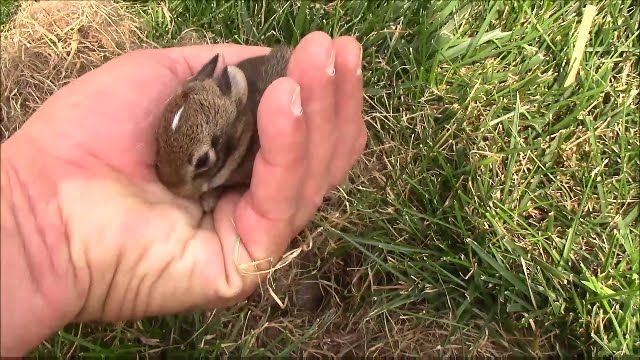 The bunny might also exhibit signs of pain, like teeth grinding and a hunched posture.
The bunny might also exhibit signs of pain, like teeth grinding and a hunched posture.
Lethargy is also an indication of other, more serious health problems, so have the bunny checked over in case of something else is going on.
Rabbit Isn’t Moving
If the orphaned baby rabbit you’ve found isn’t moving, check to see if it’s still breathing. If the rabbit has its head arched back and mouth open, it’s probably too late to save it. However, if the bunny hasn’t reached this state, it’s possible to revitalize it.
The first step is to keep it warm, especially if the animal is cold to touch. Keep it close to you to transfer your body heat or wrap it in a soft hand towel until it starts to wriggle and show signs of life.
Once the bunny has perked up, place it back into the nest to recuperate. If there is more than one rabbit, they will huddle together to keep warm. Otherwise, provide extra heat using safe methods to help the bunny maintain a healthy body temperature.
If the mother is still alive and you’ve carried out the above steps, place the bunny back into the nest and cover it with grass. Touching the nest won’t cause the mother to abandon the babies. Instead, she will return to feed them as nature intends.
Rabbit Has Been Attacked
Occasionally, you might find that a predator has attacked a baby rabbit. Even if the mother is present, the bunny will need help to prevent the wound from becoming infected; otherwise, it will only worsen.
If the wound looks fresh, it’s possible to clean it using an antiseptic solution to prevent infection. But if the injury appears old, swollen, yellow, or is oozing pus, it’s best to take the bunny to a vet for antibiotics.
Once the injury has been successfully treated, it should be safe to place the baby rabbit back into the nest. The vet will provide the bunny with milk to tide it over until the mother returns.
Caring for wild baby rabbits is a challenging task and requires around the clock attention. Newbies shouldn’t attempt any form of care without expert advice – and even then, success isn’t guaranteed. If the rabbits are orphaned, they’re unlikely to survive without their mother. However, some baby bunnies with health issues simply need a helping hand.
Newbies shouldn’t attempt any form of care without expert advice – and even then, success isn’t guaranteed. If the rabbits are orphaned, they’re unlikely to survive without their mother. However, some baby bunnies with health issues simply need a helping hand.
How to Nurse or Care for a Wild Baby Rabbit
••• standret/iStock/GettyImages
Updated April 25, 2018
By Jonae Fredericks
If you find wild baby rabbits, don't assume that they've been abandoned. Even if you see a baby rabbit alone, this doesn't mean the mother has left it forever. Mother rabbits tend to feed their babies once or twice per day, so it's normal for you to see them alone sometimes. The mothers will frequently leave the wild baby rabbits in between feedings. However, if you're confident the mother is dead and have determined that baby rabbit care is necessary, then read on to learn about nursing them.
Warnings
Wild animals can carry disease. Always handle the baby rabbit with gloved hands.

- Small cardboard box
- Soft cotton towels
- Cotton gloves
- KMR (kitten milk replacer)
- Eyedropper
- Timothy grass
Add some Timothy grass to the wild baby rabbit’s cardboard box as a supplement, once his eyes are fully open.
 Once you notice that he is eating the hay, he is ready to go back out into the wild.
Once you notice that he is eating the hay, he is ready to go back out into the wild.If you notice that the wild baby rabbit is not urinating or passing stool, he may need some assistance. Run your gloved finger gently up and down over his belly, down to his anal area. The stimulation of the massage will help him eliminate.
Don't feed a wild baby rabbit more than twice per day. Never exceed the 30-CC dose on a single day.
Observe the situation before touching the babies. If the wild baby rabbit is crying most of the day, this is usually a sign that it's abandoned. Well-fed wild baby rabbits usually sleep all day. Also, check the coloring. If the baby rabbit looks pink and plump, his mom is probably around and nursing baby rabbits. Thin, blue-skinned babies may be starving.
Prepare a warm nest for the wild baby rabbit. A small cardboard box lined with a soft cotton towel should suffice. You will need to keep the box in an area that has a constant temperature of 65 degrees Fahrenheit or higher. If this is impossible, set a heating pad under the box, set at the required temperature.
Slip on a pair of cotton gloves and scoop the baby rabbit out of the nest with your cupped hand, carefully. Place the wild baby rabbit in the box. Gently drape a second towel over the top of the cardboard box, leaving a slight opening for air circulation. A dark environment will mimic his natural nest.
Nurse the wild baby rabbit if a veterinarian is unavailable. A liquid kitten mix known as KMR (kitten milk replacer), sold in most pet stores, will provide adequate nutrition. Simply fill an eyedropper with 5 cubic centimeters of KMR if the baby is a newborn (eyes closed), 7- to 13-CC for a 2-week old baby rabbit (eyes slightly open) and 15 CC for a wide-eyed wild baby rabbit. Once the 15-CC dose has been reached, maintain that dosage until the baby is weaned.
Gather the wild baby rabbit in his blanket and feed him on his back, just as you would a human baby. Put the dropper to the baby rabbit’s mouth and allow him to suck the KMR at his own pace. Most baby rabbits will appreciate feedings twice a day. Once in the early morning and again late at night, just like in the wild.
Place the wild baby rabbit back in the cardboard box in between feedings and try not to handle him more than necessary. Check on him regularly throughout the day.
Things You'll Need
Warnings
Related Articles
References
- House Rabbit Society: Caring for Orphans
Tips
- Add some Timothy grass to the wild baby rabbit's cardboard box as a supplement, once his eyes are fully open. Once you notice that he is eating the hay, he is ready to go back out into the wild.
- If you notice that the wild baby rabbit is not urinating or passing stool, he may need some assistance. Run your gloved finger gently up and down over his belly, down to his anal area.
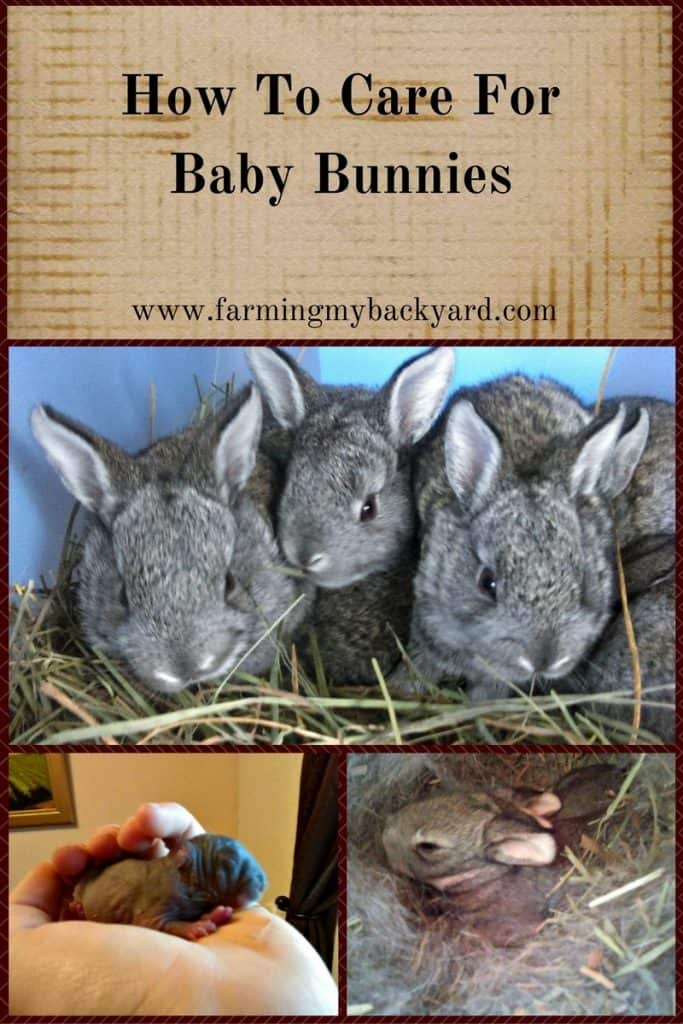 The stimulation of the massage will help him eliminate.
The stimulation of the massage will help him eliminate.
Warnings
- Do not feed a wild baby rabbit more than twice per day. Never exceed the 30-CC dose on a single day.
- Wild animals can carry disease. Always handle the baby rabbit with gloved hands.
About the Author
Jonae Fredericks started writing in 2007. She also has a background as a licensed cosmetologist and certified skin-care specialist. Jonae Fredericks is a certified paraeducator, presently working in the public education system.
proper maintenance, care and diet
Getting healthy offspring depends on the correct maintenance, care, and diet of rabbits.
Content Rules
In private farms, rabbits should be kept only in cages. This helps to properly conduct breeding work, economically consume feed, effectively treat animals and carry out prevention. In the central regions, rabbits can be kept in open air cages throughout the year. In the northern and northeastern regions of the country, it is more correct to use the combined method, which uses mainly lightweight portable cages.
In the northern and northeastern regions of the country, it is more correct to use the combined method, which uses mainly lightweight portable cages.
Arrange them indoors in order to save space should be in 2-3 tiers. When placing cages in a yard or barn, it must be borne in mind that rabbits do not tolerate drafts, high or low air humidity. You can not place cages in the lowlands near the marshes, where there are often fogs and the relative humidity of the air is very high.
Rabbits feel bad in places with relative humidity below 50%.
When placing cages in sheds, it is necessary to ensure clean air and sufficient illumination, the duration of daylight hours is at least 8–10 hours and not more than 16 hours per day. Cages for adult rabbits of large and medium meat-skin and downy breeds can be single-section and two-section. Two-section cages have feeding and nesting sections. Single-section cages are recommended to be made 120 cm long, 60 cm wide; two-section -130 and 60 cm, respectively; aft compartment length 90 cm, nesting 40 cm. Cage height 45–60 cm. For rabbits of large breeds with an adult weight of 5 kg or more, it is better to increase the length of the cage to 150 cm.
Cage height 45–60 cm. For rabbits of large breeds with an adult weight of 5 kg or more, it is better to increase the length of the cage to 150 cm.
The size of the group cage for young animals is determined by the number of rabbits. Usually the length of the cage is 300 cm, the width is 100 cm, and the height is from 35 to 60 cm. In a group cage of the specified size, you can keep up to 10 heads of marketable young animals or up to 7 heads of replacement young animals.
The area norm for one adult rabbit in a one-section cage is 0.72 sq. m, in a two-section - 0.78 sq. m. When grouping young animals on a mesh or slatted floor, the cage area per head must be at least 0.12 square meters. m for commercial young animals and 0.17 sq. m for replacement young rabbits of the meat-skin direction of productivity and downy breeds, and when kept on a solid wooden floor, respectively, 0.25 and 0.3 square meters. m.
Young animals older than 3 months of age are kept one per cage in the summer, and in groups in the winter.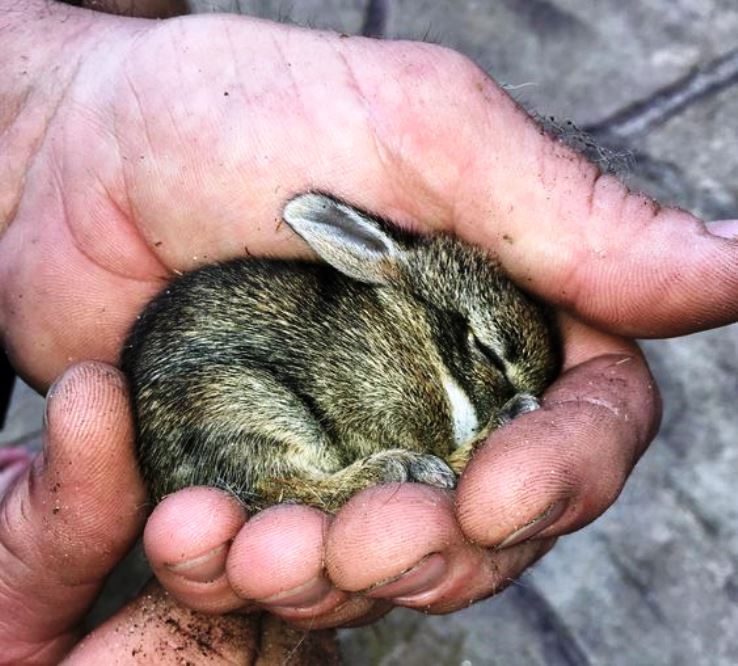 Groups should be formed immediately when jigging young animals from rabbits. In each group, rabbits of the same sex and approximately the same body weight, age and temperament should be selected. If there are pugnacious animals in the group (optimally 10 rabbits), they must be separated and kept separately.
Groups should be formed immediately when jigging young animals from rabbits. In each group, rabbits of the same sex and approximately the same body weight, age and temperament should be selected. If there are pugnacious animals in the group (optimally 10 rabbits), they must be separated and kept separately.
Particular attention should be paid to the arrangement of the cell floor.
In areas with a warm and temperate climate, when placing cages in the yard when receiving rounds throughout the year and in other areas, when receiving rounds only in the spring and summer, it is more correct to make floors entirely from welded mesh or slats from hardwoods (oak, maple, beech, etc.) The same floor should be in portable cages. In other cases, cages should be built with solid plank floors, and even better, a double floor should be arranged. Solid board floors should be inclined towards the rear wall (by 5 cm). A double floor can be arranged in several ways (for example, by laying a removable tessellated floor over the mesh floor or by arranging a folding tessel floor under the mesh floor). Long-term keeping of rabbits on the same mesh floor is undesirable, because this leads to paws and the disease of rabbits with pododermatitis. When installing mesh floors, it is advisable to place removable floors there, which must be cleaned daily of dirt.
Long-term keeping of rabbits on the same mesh floor is undesirable, because this leads to paws and the disease of rabbits with pododermatitis. When installing mesh floors, it is advisable to place removable floors there, which must be cleaned daily of dirt.
Nutrition, diet, fattening
The main foods in summer are grasses: cereals, legumes (clover, alfalfa, vetch), weeds (wormwood, plantain, sow thistle, spurge, dandelion, yarrow, nettle, burdock, colza). The leaves of root crops, aspen, linden, willow, mountain ash, etc. also come into play. Grass of leguminous plants should be given in a mixture with cereal herbs so as not to cause intestinal diseases. It is not recommended to feed the same grass all the time. It has been noticed, for example, that rabbits who are given only dandelions noticeably lag behind in growth.
Remember, plants such as hemlock, dope, henbane, digitalis, lily of the valley, raven eye, larkspur, celandine, POISONOUS!
Of the roughage for rabbits, meadow or legume hay (well leafy), brooms from young branches, and spring straw are suitable. From vegetables - carrots, beets, turnips, potatoes, pumpkin, watermelon peels, cabbage. Concentrated feed - oats, barley, corn, peas, vetch, lentils, bran, compound feed. Rabbits willingly eat apples, mountain ash, acorns, potato peels, dairy feed (milk, skim milk, curdled milk), mineral (salt, chalk, bone meal).
From vegetables - carrots, beets, turnips, potatoes, pumpkin, watermelon peels, cabbage. Concentrated feed - oats, barley, corn, peas, vetch, lentils, bran, compound feed. Rabbits willingly eat apples, mountain ash, acorns, potato peels, dairy feed (milk, skim milk, curdled milk), mineral (salt, chalk, bone meal).
In winter, raw root crops and tubers are good. Frozen root crops are boiled, and carrots are thawed and given raw. Hay is the main food for rabbits in winter, but they do not eat well harvested, coarse hay. In winter, in addition to hay, freshly chopped branches of trees and shrubs with bark can be given at night. The best concentrated food is oats. It is fed dry. Other grains (peas, corn, lentils) should be soaked 2-3 hours before feeding. Bran is given slightly moistened, barley - in crushed form. Mineral feeds are mixed with concentrates.
Rabbits need to be fed daily. In cold weather, all rabbits, with the exception of lactating queens, can be watered once a day with water at room temperature, and the rest of the time snow is placed in the drinkers.
To get tasty and nutritious meat, it is best to feed young animals for a month at the age of 3.5–4 months or adult rabbits. Rabbits get used to a certain regime, which should be followed.
The first 10 days after the start of fattening rabbits significantly reduce the amount of hay and increase the amount of concentrates. For the next 10 days, the rabbits are given foods that promote intensive fat deposition: corn, oats, barley, lightly boiled salted potatoes mixed with bran. For the last 10 days, rabbits should be fed so that they have the maximum amount of food.
This can be achieved by feeding aromatic herbs - dill, parsley, celery, and other plants willingly eaten by these animals. At the same time, various concentrates are given, their composition is often changed. Roughage is fed the minimum amount.
Rabbits fatten best if they are caged one at a time. A well-fed rabbit becomes round in shape, the fur on it is smooth and shiny.
Healthy offspring
For mating, strong, plentifully milky females are allowed, well feeding rabbits.
If there are several females, it is necessary to record important information: the date of birth, from which parents it was received (in order to prevent inbreeding in the future), the dates of mating and birth, the number of rabbits in the litter, including the number of stillborns. Cases of eating rabbits by the female and other indicators that must be taken into account when determining the breeding value of the female are noted. Females eating rabbits are taken out of the herd.
The male and female must be of good fatness, females with low fatness are fertilized with difficulty or they bring weak rabbits, they are poorly raised. Therefore, 2–3 weeks before mating, females begin to be intensively fed with hay, oats, boiled potatoes with bran, branch food.
However, it must be borne in mind that obese females and males lose sexual activity, they should reduce the amount of feed.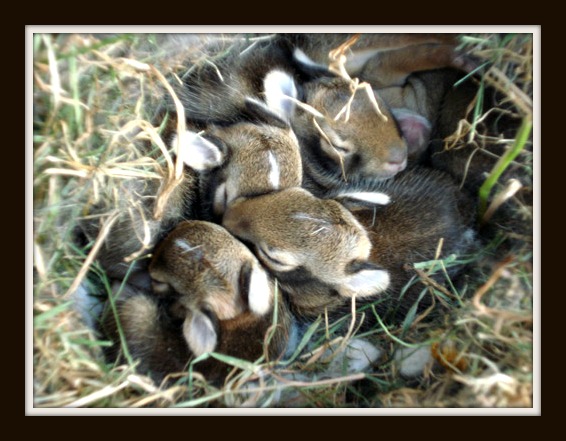
The first hunt in females appears at the age of 3.5–4 months. But normally developed females of medium-weight breeds (chinchilla, Viennese blue, downy) can bring a healthy, viable offspring only at the first covering at the age of 4-5 months with a live weight of 2-2.8 kg, females of large breeds (white giant, gray giant) - at the age of 5-6 months with a live weight of 3.5-3.8 kg.
The male can be mated for the first time at 8 months. Males that produce good offspring can be used for 4–5 years, and on average 2–3 years. Females are used for an average of 3-4 years. But if the female gives multiple litters, grows healthy, large rabbits, then you can use it longer. In order to receive rounds all year round, they draw up an approximate mating plan, given that the breeding lasts 28–31 days. At the same time, 2-3 females should be rabbits, so that it is possible to transplant some of the rabbits from low-dairy animals to more dairy ones.
To obtain strong, viable rabbits, the female rabbit must be properly fed and maintained. They keep her in a separate cage, because female females behave restlessly in the presence of another animal. There may be fights between them, which can lead to an abortion. In the cage of the female, it should be clean and dry all the time; in the cold season, clean, dry bedding is laid in the cage for insulation. During pregnancy, especially in the second half, when the embryos grow rapidly, females are fed with good hay, grains of cereals and legumes, be sure to give juicy food (carrots, washed potatoes, cabbage), and in summer - green grass.
They keep her in a separate cage, because female females behave restlessly in the presence of another animal. There may be fights between them, which can lead to an abortion. In the cage of the female, it should be clean and dry all the time; in the cold season, clean, dry bedding is laid in the cage for insulation. During pregnancy, especially in the second half, when the embryos grow rapidly, females are fed with good hay, grains of cereals and legumes, be sure to give juicy food (carrots, washed potatoes, cabbage), and in summer - green grass.
Immediately after the birth, after removing the female from the cage, it is necessary to inspect the nest, carry away the weak and stillborn rabbits. It is imperative to remove the female during the inspection of the nest, because she worries, rushes around the cage and can damage the rabbits.
If the female does not allow the rabbits to the nipples, which is most often the case with primiparas, force-feeding must be applied.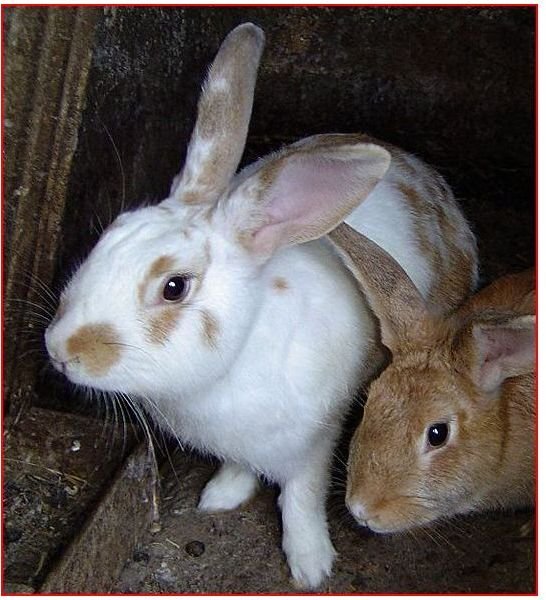 To do this, the rabbits, together with the female, are transferred to a warm room, they put the female on her back or on her side, hold her front and hind legs, and put the rabbits to her nipples. When all the rabbits are fed, they are carried away with the female to the nest. After 2 hours, this feeding is repeated and this is done until the rabbits get stronger and find the nipples themselves. In the early days, you need to monitor whether the rabbits have enough milk. Rabbits must receive mother's colostrum.
To do this, the rabbits, together with the female, are transferred to a warm room, they put the female on her back or on her side, hold her front and hind legs, and put the rabbits to her nipples. When all the rabbits are fed, they are carried away with the female to the nest. After 2 hours, this feeding is repeated and this is done until the rabbits get stronger and find the nipples themselves. In the early days, you need to monitor whether the rabbits have enough milk. Rabbits must receive mother's colostrum.
It is possible to lay baby rabbits with another rabbit only if both females and their offspring are healthy.
Before transferring rabbits to someone else's nest, you should thoroughly wash your hands in warm water without soap: your hands should be warm and free of foreign smell! Rabbits from another nest have their own smell, inherent only to them.
The rabbit, to which the rabbits are placed, can smell this smell and bite the adoptees.
Therefore, rabbits are planted in the absence of a female nurse. They wipe them down with fluff from that nest, put them somewhere, and place them in the middle of someone else's droppings. After 15–20 minutes, the young acquire the smell of a new nest, and the nurse rabbit cannot distinguish them.
During the suckling period, one should observe not only the rabbits, but also the rabbit. Sometimes the female develops mastitis - inflammation of the mammary gland. If a slight redness and slight hardening appear on the rabbit's abdomen, treatment should be started without starting the disease.
With normal development of rabbits at the age of one month, the white and gray giant breeds have a weight of 600–700 g, Viennese blue and silver - 450–550 g, chinchilla - 450–500 g, white downy - 400–450 g.
With compacted births, when the female happens to the male shortly after the birth, the rabbits are planted all at the same time at the age of 27–28 days. But young growth grows much better if it is taken away from a rabbit at the age of 45 days. Such rabbits get used to roughage gradually, while still receiving mother's milk, which facilitates the transition to plant foods. With early jigging, up to 1 month, in the first days, digestion worsens in young animals, so in the first week it is necessary to slightly reduce the amount of roughage.
But young growth grows much better if it is taken away from a rabbit at the age of 45 days. Such rabbits get used to roughage gradually, while still receiving mother's milk, which facilitates the transition to plant foods. With early jigging, up to 1 month, in the first days, digestion worsens in young animals, so in the first week it is necessary to slightly reduce the amount of roughage.
Before weaning the rabbits from the female, it is necessary to prepare cages for them, equip them with feeders and drinkers. 3-4 rabbits of the same weight and fatness are planted in each cage. Preferably they should be from the same litter.
Scientific consultant - Nikita Vladimirovich Nosov, biologist, post-graduate student of the Russian Academy of Agricultural Sciences VNIIGRZH.
How to feed baby rabbits without a female rabbit from the first days of life
From time to time, farmers have to face the problem of how to feed baby rabbits without a female rabbit. The reasons for the need may be different, but the solution is always equally necessary. In this position, the efficiency and fidelity of actions directly affect the survival of babies. Any mistake can lead to the death of the offspring in just a few hours.
The reasons for the need may be different, but the solution is always equally necessary. In this position, the efficiency and fidelity of actions directly affect the survival of babies. Any mistake can lead to the death of the offspring in just a few hours.
How to feed baby rabbits without a female rabbit
Contents of the article
- 1 Is it possible to feed baby rabbits without a female rabbit?
- 2 What can replace rabbit milk?
- 3 Rules for feeding
- 4 Artificial feeding rabbits by age
- 4.1 from birth to 5 days
- 4.2 from 6 to 14 days
- 4.3 - how to feed the rabbit through syringe
- 4.4 from 15 to 30 days
- 5 What to feed baby rabbits per month?
- 5.1 Fummers for rabbits
- 6 top feeding
- 7 DPDIs and disadvantages of young animal feeding
- 8 Care for artificial feeding
- 8.1 MANY FOR ROOM
It is possible to feed rabbit offspring without a female, although the process will require a waste of time and money.
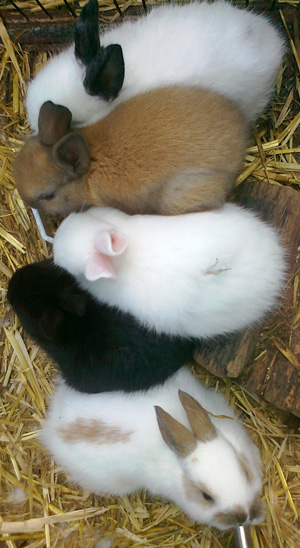 The organization of such a meal obliges you to purchase some accessories, follow schedules, be with the kids a lot. The main difficulties occur in the first weeks of the life of rabbits. As they grow older, the need for constant support disappears, the animals become independent.
The organization of such a meal obliges you to purchase some accessories, follow schedules, be with the kids a lot. The main difficulties occur in the first weeks of the life of rabbits. As they grow older, the need for constant support disappears, the animals become independent. Babies with a rabbit
Artificial feeding is considered undesirable unless absolutely necessary. Wrong actions can reduce the percentage of survival. Third-party nutrition, human care will not completely replace mother's milk and care. Meanwhile, there are cases when orphaned babies grew up stronger, thanks to the hard work of breeders.
Newborn rabbit
Procedure required for certain problems:
- death of female . Sometimes the rabbit dies during or after childbirth. It is very difficult to predict the sad outcome;
- atrophied parental instinct . Often occurs in the first litter in young individuals. The newly-made mother does not want to feed her offspring.
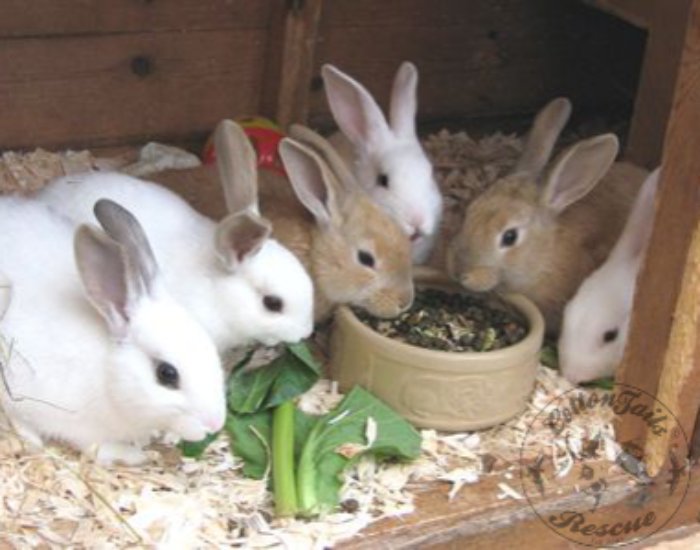 In most cases, the instinct can be awakened forcibly by holding the female several times in the process of feeding the babies. However, there are times when no tricks help;
In most cases, the instinct can be awakened forcibly by holding the female several times in the process of feeding the babies. However, there are times when no tricks help; - passion for hunting . Restless rabbits can abandon children within a day after giving birth. They begin to run around the living space, furiously looking for food. In such impulses, rabbits often die from accidental trampling by their own mother. The problem is solved by provocation. Mating is carried out with a male incapable of conception. After that, the female can calm down. If the attempt is unsuccessful, artificial feeding cannot be avoided;
- sore nipples . It is also more common in young rabbits. Roughened skin does not allow milk to pass quietly, the process causes severe inconvenience to the mother and she stops letting offspring;
- strong odors . Rabbits are sensitive to foreign odors. The most unpleasant for them are shades of alcohol, perfume, household and technical liquids.
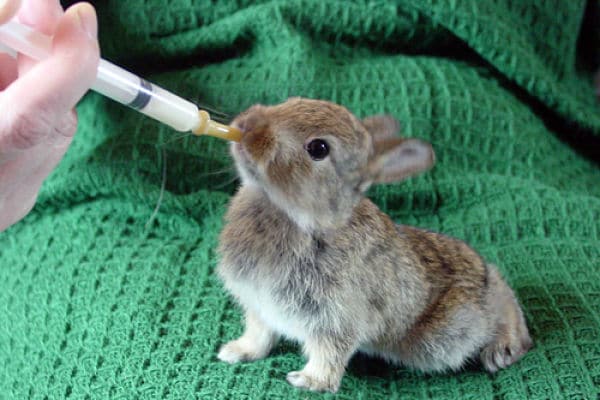 Sometimes the smells of other animals living in the neighborhood play a cruel joke. Discomfort leads to the damping of instincts.
Sometimes the smells of other animals living in the neighborhood play a cruel joke. Discomfort leads to the damping of instincts.
Feeding of young rabbits by another mother
In these situations, if possible, try placing the babies on another mother. However, not every rabbit will willingly accept someone else's offspring. In addition, a large number of babies will lead to exhaustion of the female. Therefore, experienced farmers prefer to immediately get down to business on their own.
See also: The rabbit does not feed the rabbits: what to do?
It happens that the rabbit refuses to feed newborns. Everyone who breeds rabbits should know what to do in such a situation. Why the rabbit does not feed the rabbits and how to deal with the problem, we will tell in the article.
What can I substitute for rabbit milk?
Newborn rabbits are recommended to be fed with quality substitutes.
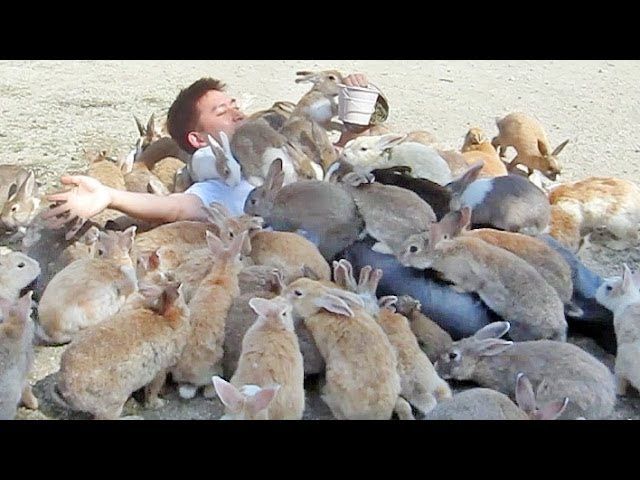 This is the only way they can get the maximum amount of nutrients. Valid options are:
This is the only way they can get the maximum amount of nutrients. Valid options are: As for cow's milk, opinions differ. Some farmers consider it categorically unacceptable for rabbits. Other breeders claim that such a substitution is possible when there are no other options. Cow's milk differs significantly from rabbit's in composition, fat content, and ability to be digested. In its pure form, it does not satisfy the needs of small rabbits. Some sources suggest mixing whole cow's milk with condensed milk (preferably without sugar) 4 to 1. But this mix is classified as emergency.
Cow's milk can be used when there are no other options
Rules for feeding
Rabbits are born blind, without hair on the body, weighing about 60 g. Without the ability to see and move freely, nutritional skills are absent. Babies are completely defenseless, so the loss of a nursing mother is a very dangerous phenomenon for them. A person must perform the functions of a rabbit.
 You will need to master certain skills, acquire inventory.
You will need to master certain skills, acquire inventory. Newborn rabbits
In the first days of life, babies need a nipple. It can be played by:
- large pipette;
- 20 ml syringe without needle;
- clean bottle of eye drops;
- small size baby bottle;
- special kit for animal feeding.
Feeding set 1
Syringe and drop bottle crafted to make feeding easier. The rubber cap from the pipette is put on the spout of the selected container. Previously, several punctures are made in the rubber. In store kits there is a special syringe and tips of different sizes. As the rabbits grow, the devices can be changed, moving from a pipette to a bottle. From day 20, most babies begin to eat from a saucer on their own.
Feeding set 2
Feeding should be built as close to natural flow as possible. The more accurately the details are copied, the faster the animals will acquire instincts. Until the eyes open, newborns show little reaction to the artificial nipple.
 Milk has to be poured into the mouth. It is important to squeeze out the liquid gradually so that the baby does not choke. The first 2-3 days it is better to start feeding by smearing milk around the mouth. The rabbit will lick it himself. For inactive individuals, the procedure is repeated several times. If the rabbit perks up when he feels the taste of food, you can already proceed to the infusion of a few drops.
Milk has to be poured into the mouth. It is important to squeeze out the liquid gradually so that the baby does not choke. The first 2-3 days it is better to start feeding by smearing milk around the mouth. The rabbit will lick it himself. For inactive individuals, the procedure is repeated several times. If the rabbit perks up when he feels the taste of food, you can already proceed to the infusion of a few drops. Feeding should be built as close as possible to the natural flow
A blind baby can eat no more than 1 ml of milk at a time. The stomach should not be full. Overfeeding threatens with gastric disorders, inflammation of the respiratory system. The rabbit must be held vertically in the hand, without squeezing the body. The liquid is stored in the refrigerator for no more than 72 hours, heated before the procedure to 37-38°C. The mixture is always prepared fresh.
Keep baby upright
The easiest way to determine the optimal feeding times is to observe the behavior of the young.
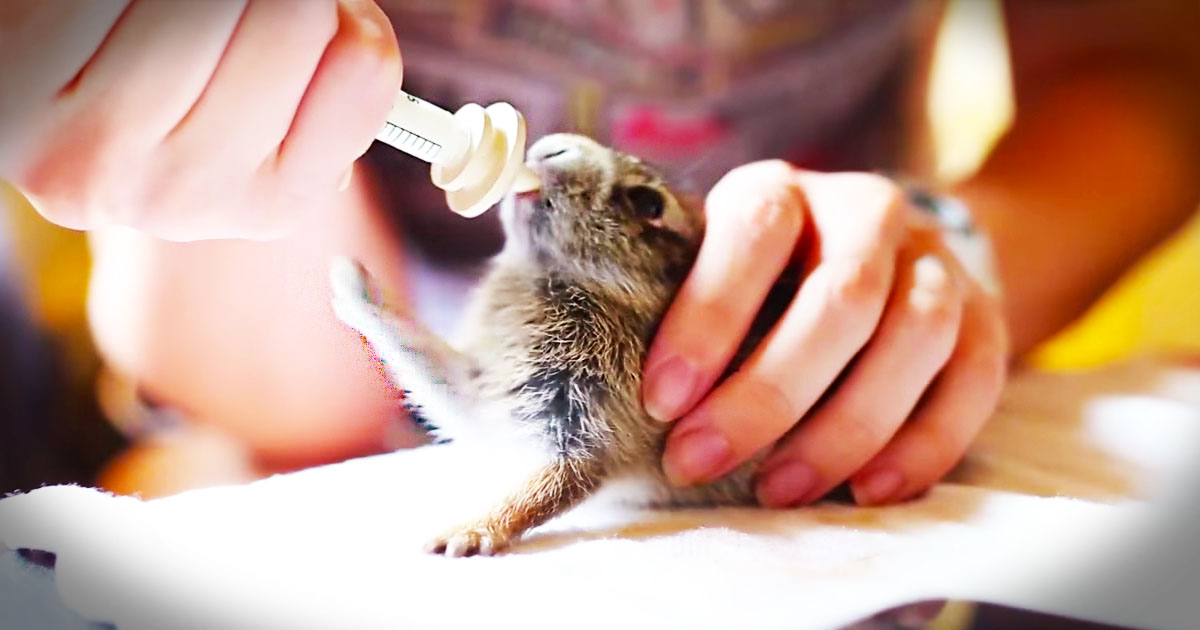 Well-fed cubs behave calmly, quietly, sleep a lot. In a hungry state, they become restless, try to move around in search of a mother and squeak.
Well-fed cubs behave calmly, quietly, sleep a lot. In a hungry state, they become restless, try to move around in search of a mother and squeak. Artificial feeding of rabbits by age
Each age of rabbits requires its own feeding schedule. The frequency is adjusted according to the speed of digestion of food. Appetite increases with the growing body. By the end of the first week, babies are already able to overeat, so following the rules is necessary for their health. Until the 30th day, the diet consists only of milk.
Up to a month, only milk is included in the diet
From birth to 5 days
A newly born rabbit is given literally 1 drop of liquid. During the day, the number of drops is increased gradually in 5-6 visits. The animal does not yet have a good swallowing reflex, so special care is needed. From the second day it is enough to feed 4-5 times. By the end of the period, the baby should double its birth weight (120-180 g for different breeds).
 On the fifth day, food is given 4 times.
On the fifth day, food is given 4 times. Pipetting
Days 6 to 14
From day 6, young rabbits are fed three times a day. This mode lasts up to 2 weeks of life. During this time, the weight of the babies reaches 200-260 g. Portions gradually grow along with the animals.
Syringe nipple
Video - How to feed a rabbit through a syringe
From 15 to 30 days
On days 15 and 16, individuals are transferred to a two-time diet. They observe their behavior, if there is not enough food, add a little mixture in the form of a third feeding. From the 17th day onwards, portions become impressive, the body prepares for the adult regimen, so two feedings do not exceed. By day 30, the rabbits weigh about 500 g.
 Depending on the breed, the weight may be slightly less or more. Weaning from the nipple begins by the end of the third week. Early maturing species are often ready for the introduction of other products already on the 20-25th day. Readiness can be tracked by the behavior and condition of the teeth. When milk teeth are almost completely replaced by molars, interest in solid food wakes up, the animal is transferred to a new food.
Depending on the breed, the weight may be slightly less or more. Weaning from the nipple begins by the end of the third week. Early maturing species are often ready for the introduction of other products already on the 20-25th day. Readiness can be tracked by the behavior and condition of the teeth. When milk teeth are almost completely replaced by molars, interest in solid food wakes up, the animal is transferred to a new food. Baby bunny drinking milk from a bottle
Increase the amount of milk as it grows. The larger the breed, the larger the single serving.
Feeding rate per 1 individual per day (for 1 feeding) 1-7 days 5 ml (1 ml) 8-14 days 20 ml (5 ml) 15-20 days 20-26 ml (10-13 ml) 21-30 days 30-50 ml (15-25 ml) What to feed baby rabbits per month?
When the rabbits gain strength, the teeth will get stronger, they begin to connect solid food.
 Some farmers completely exclude milk by 31 days. Others prefer to keep it as a supplement in small amounts. Experts recommend leaving dairy food only with weight loss.
Some farmers completely exclude milk by 31 days. Others prefer to keep it as a supplement in small amounts. Experts recommend leaving dairy food only with weight loss. Hay is added to the diet
New food is offered to rabbits from 3 weeks of age. Even during the period of milk nutrition, small heaps of hay are placed on them. It is important to observe the baby's stool. The slightest signs of diarrhea serve as a stop signal for feeding. Disorders of the gastrointestinal tract for these animals are very dangerous, since digestion after them may not recover. If the introduction was successful, gradually add small grass, a few granules of compound feed, a pinch of grated carrots. So the transition to adult food is as smooth as possible.
Feed prices for rabbits
Feed for rabbitsThe intestines of a monthly rabbit are able to digest food without stagnation. The basis of the diet is now made up of granular mixtures, greens and hay, oatmeal flakes, vegetables, root crops.
 All food must be fresh.
All food must be fresh. Babies start eating on their own
Granules include the necessary vitamin premixes. Their size varies, so a serving per individual is considered 3% of the individual's weight. Carrots, cabbage leaves are crushed at first, then they begin to be given in large pieces. Beets, potatoes, turnips are given only for fodder, not more than 1-2 times a week. Dry food must be moistened, otherwise they irritate the respiratory tract of rabbits. Animals should always have access to clean drinking water.
Monthly rabbit food pyramid
Always leave only hay and water in the feeding area. The rest of the food is laid according to the regimen, the remains are removed daily.
Feeding norms for a rabbit from 1 month. Gram per day for 1 individual Concentrated granules 40-60 g Hay 120-150 g Grass 300-500 g Vegetables, roots 150-200 g In winter, the norms are calculated according to the upper permissible limit.
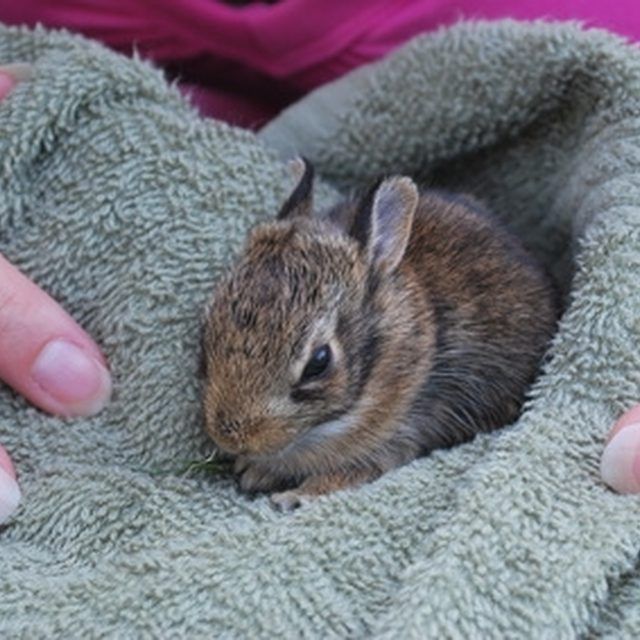 In summer, the amount of grass is increased, and the granular feed is reduced to a minimum.
In summer, the amount of grass is increased, and the granular feed is reduced to a minimum. Granular food
It is forbidden to feed baby rabbits with sprouted potatoes, wild herbs, branches of unknown trees. Many breeds are poisonous to these animals; it is necessary to study acceptable plants in advance. Food with mold, rot, dirt, fungus, frozen areas can also cause irreparable harm to the pet's body.
See also: What not to feed rabbits
In this article, you can get acquainted with prohibited foods for rabbits, as well as what food will keep their health in order.
Feedings
The milk of a healthy rabbit can provide the offspring with all the necessary vitamins. On artificial feeding, newborn animals need help in the form of feeding. Ready mix substitutes often already contain premixes. In their absence, special preparations are added to natural milk on their own:
Premixes may also be present in pelleted feed.
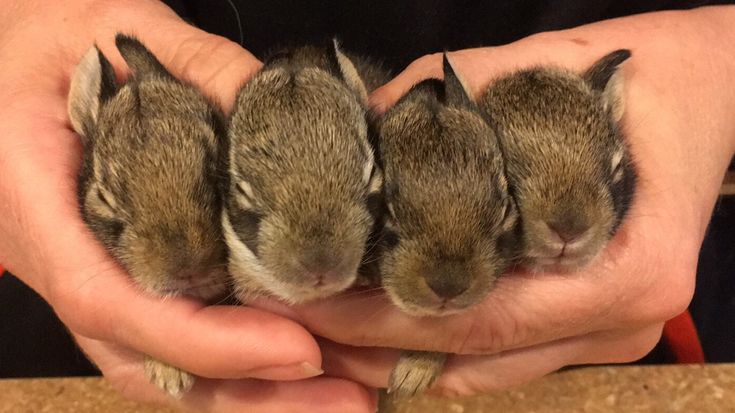 From day 31, you need to make sure that the total amount of top dressing is within the acceptable range.
From day 31, you need to make sure that the total amount of top dressing is within the acceptable range. Experienced zookeepers recommend giving the following mixture during the change of feed:
- 4 parts of hay or grass meal;
- 3 parts barley;
- 2 parts peas or corn;
- 2 parts sunflower meal;
- 1 part wheat bran.
Homemade dressing
All ingredients are ground into coarse flour and given a pinch from the 20th day. From day 31, all or part of the pelleted feed can be replaced with this mixture.
Advantages and disadvantages of artificial feeding of young animals
Artificial feeding is always a last resort when rearing offspring. The main disadvantage of this approach is the inability to give the kids the whole set of necessary trace elements. All substitutes remain only close to rabbit milk. A product from other animals, mixtures, one way or another, remain unbalanced specifically for rabbits.
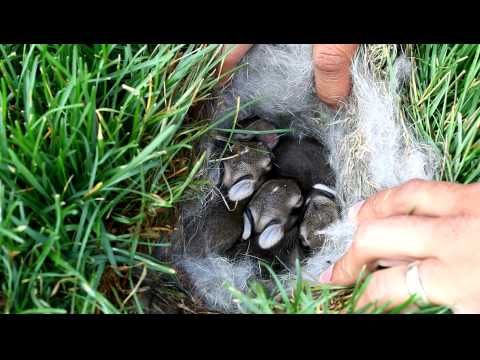
Baby rabbits get all the nutrients they need when fed naturally. This process often causes difficulties, slows down the formation of the swallowing reflex. In addition, there is a risk of making incorrect actions and harming the animal, and getting a substitute for native milk can be problematic and expensive. Another disadvantage is the need for a person to be present almost all day.
Plus of artificial feeding - unpretentiousness of rabbits in terms of nutrition
The main advantage of artificial feeding is the unpretentiousness of rabbits in terms of nutrition. Such animals quickly get used to new products, do not refuse top dressing because of the unusual taste, and have a good appetite. It is also easier to develop the habit of feeding on a schedule, to regulate the content of vitamins for individual ears.
Care of artificially fed rabbits
Immunity in artificially fed rabbits develops much more slowly than in offspring growing on mother's milk.





